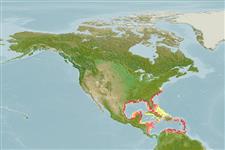>
Eupercaria/misc (Various families in series Eupercaria) >
Sciaenidae (Drums or croakers)
Etymology: Cynoscion: Greek, kyon = dog + Greek, odous = teeth + Greek, skion, skiaina = barbel, red mullet (Ref. 45335).
Environment: milieu / climate zone / depth range / distribution range
Écologie
marin; saumâtre démersal; profondeur 2 - 18 m (Ref. 1183). Subtropical; 39°N - 9°N, 98°W - 59°W
Western Atlantic: Maryland to northeastern Florida in the USA and throughout Gulf of Mexico. Reported from Campeche Bank in Mexico (Ref. 5733). Often misidentified as Cynoscion regalis (Ref. 3702).
Length at first maturity / Taille / Poids / Âge
Maturity: Lm 15.8, range 14 - 17 cm
Max length : 36.0 cm TL mâle / non sexé; (Ref. 3702); common length : 25.0 cm TL mâle / non sexé; (Ref. 3702); âge max. reporté: 1.20 années (Ref. 31629)
Épines dorsales (Total) : 11; Rayons mous dorsaux (Total) : 26 - 31; Épines anales: 2; Rayons mous anaux: 8 - 11; Vertèbres: 27. Colour greyish above and changing abruptly to silvery below. Back and upper sides sometimes with very faint irregular rows of spots. Dorsal fin dusky, other fins pale to yellowish. Mouth large, oblique, lower jaw projecting. Upper jaw with a pair of large canine-like teeth at tip. Lower jaw with a row of sharp enlarged inner-row teeth, widely spaced. Chin without barbels or pores. Snout with 2 marginal pores. Gas bladder with a pair of straight, horn-like anterior appendages. Soft portion of dorsal fin covered with small scales on basal half of in (Ref 51721).
Occurs usually over sandy bottoms in inshore waters along beaches and in river mouths. Feeds mainly on crustaceans and fishes.
Life cycle and mating behavior
Maturité | Reproduction | Frai | Œufs | Fécondité | Larves
Robins, C.R. and G.C. Ray, 1986. A field guide to Atlantic coast fishes of North America. Houghton Mifflin Company, Boston, U.S.A. 354 p. (Ref. 7251)
Statut dans la liste rouge de l'IUCN (Ref. 130435: Version 2024-1)
Menace pour l'homme
Harmless
Utilisations par l'homme
Pêcheries: intérêt commercial mineur; pêche sportive: oui
Outils
Articles particuliers
Télécharger en XML
Sources Internet
Estimates based on models
Preferred temperature (Ref.
123201): 23.4 - 28, mean 26.8 °C (based on 492 cells).
Phylogenetic diversity index (Ref.
82804): PD
50 = 0.5000 [Uniqueness, from 0.5 = low to 2.0 = high].
Bayesian length-weight: a=0.01230 (0.00776 - 0.01949), b=3.01 (2.88 - 3.14), in cm total length, based on LWR estimates for this species & Genus-body shape (Ref.
93245).
Niveau trophique (Ref.
69278): 4.0 ±0.60 se; based on food items.
Generation time: 5.0 ( na - na) years. Estimated as median ln(3)/K based on 1
growth studies.
Résilience (Ref.
120179): Milieu, temps minimum de doublement de population : 1,4 à 4,4 années (K=0.22).
Fishing Vulnerability (Ref.
59153): Moderate vulnerability (38 of 100).
Nutrients (Ref.
124155): Calcium = 88.6 [49.6, 178.0] mg/100g; Iron = 0.932 [0.487, 1.800] mg/100g; Protein = 19 [18, 21] %; Omega3 = 0.33 [0.18, 0.55] g/100g; Selenium = 16 [8, 33] μg/100g; VitaminA = 17.9 [5.9, 62.9] μg/100g; Zinc = 0.905 [0.638, 1.335] mg/100g (wet weight); based on
nutrient studies.
